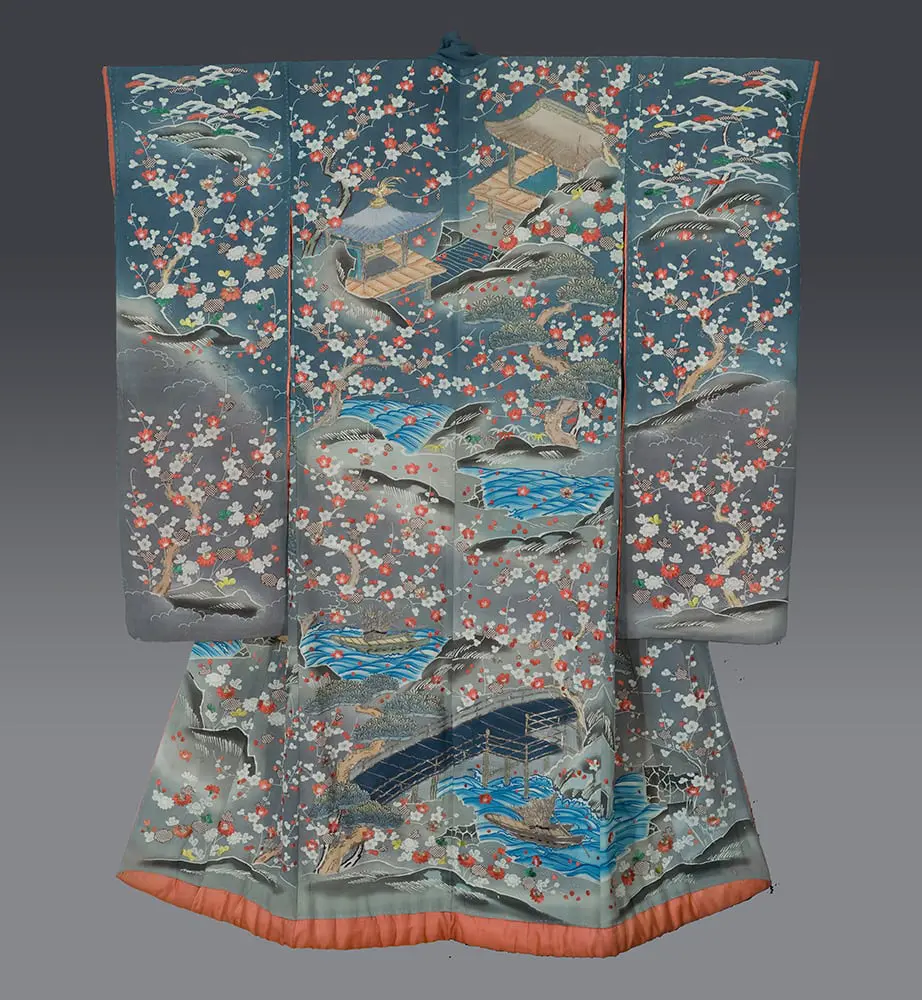Heading
This exquisite mid-19th century uchikake represents the pinnacle of Japanese textile artistry, showcasing a sophisticated integration of multiple traditional techniques to create a deeply poetic landscape composition. The garment displays a comprehensive rural scene that flows seamlessly across the silk surface, embodying the Japanese aesthetic principle of capturing the essence of nature's seasonal beauty.
The artistic approach demonstrates clear influences from classical Japanese painting traditions, particularly yamato-e (Japanese-style painting) and literati painting. The composition features traditional motifs arranged in a narrative landscape: elegant pavilions with distinctive rooflines, arched bridges spanning flowing rivers, small boats navigating waterways, majestic pine trees with characteristic needle clusters, and delicate plum blossoms (ume) scattered throughout the scene.
The technical execution is remarkable in its complexity and refinement. The yuzen paste-resist dyeing technique allows for precise color control and crisp detail work, while the sumi-e ink painting elements add spontaneous, calligraphic brushwork that brings life and movement to the design. The bokashi graduated dyeing creates atmospheric depth and dimensional modeling, particularly visible in the rendering of water, sky, and architectural forms.
The extensive use of gold thread couching and silk embroidery elevates certain elements - likely the architectural details, tree branches, and water patterns - creating textural richness and catching light to enhance the overall luminosity of the piece. The coral-orange lining visible at the hem provides a warm contrast to the predominantly cool gray-blue palette.
Its inner lining and lower hem feature a fine beni red silk that softens to a dark salmon color, with very light padding between this monochrome lining and the outer patterned layer. Exceptionally preserved, this garment remains in excellent condition, a rarity for such delicate, older garments.
Measuring 51 inches (130 cm) from sleeve-end to sleeve-end and standing at 63 inches (160 cm) in height, this uchikake likely served as a wedding over-kimono for a bride in a samurai household. The depicted scenes of bridges and pavilions possibly represent actual structures of the time, including the potential representation of the Uji bridge in Kyoto—an example of "meisho-e," scenes of famous places. A bride adorned in a meisho-e robe symbolized not only financial stability but also the leisure to visit such esteemed locales.
This artwork is featured on pages 368-371 of Ceremonial Textiles of Japan, 18th to 20th Centuries. This book, published by Yorke Antique Textiles, can be previewed or purchased on our website here.
.avif)



















